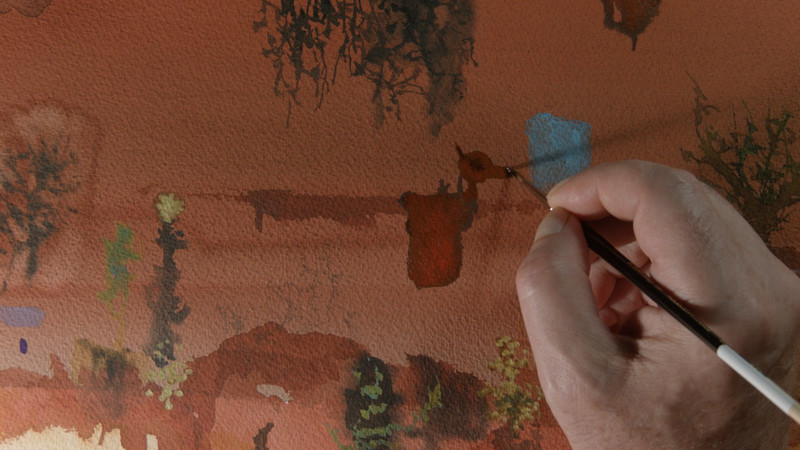
“Bob Ross was wrong,” John Lurie says. “Everybody can’t paint. It’s not true. So.” In his hand he’s got a delicate paintbrush and a pair of glasses, the better to paint and to see you with. That’s because John Lurie can paint. He can also make television. In “Painting With John,” HBO’s magnetic new series from the multidisciplinary artist, there’s plenty of painting, and no small amount of instruction—at least of a sort. Lurie’s series isn’t about learning to paint happy little trees. It’s about living, seeing, and rolling a tire down a hill; yes, it’s also about painting, but this ain’t school. It’s something much less easily classified. And besides, as Lurie tells us, “My trees are miserable.”
It’s tempting to think of the six-episode series, which premieres Friday, as a sequel of sorts to “Fishing With John,” Lurie’s cult favorite 1991 series which saw the artist and a famous-friend-of-the-week head out in pursuit of one sort of catch or another in various far-flung locales. “Painting” and “Fishing” certainly share some DNA—given that each brief six-episode series is entirely written and directed by Lurie, it would be strange if they didn’t—but while “Fishing” has the kind of gonzo energy you’d expect from a show in which Jim Jarmusch tries to tempt a shark with cheese and Tom Waits puts a fish down his pants, the surreality of “Painting” is far more meditative. (That said, “Fishing” is a fascinating companion to this series; it’s currently streaming on The Criterion Channel and is well worth your time.) Symptoms of advanced Lyme disease, Lurie tells the camera, have forced the artist to give up music and many other creative pursuits. Now living on an island equally beautiful and remote, he’s turned to watercolors. Before a canvas, he’s contemplative and at ease, a stark contrast to his relationship to the camera, which is alternately and sometimes simultaneously playful, intimate, and adversarial. “Fishing” is a bonzer adventure in style and form as well as reality; “Painting” is a hand reaching straight through the solar plexus to squeeze.
And squeeze, it does. It’s a rare thing to encounter a work of art you can describe as both daffy and mournful, yet “Painting” is certainly such a creature. It might be more at home on the shelf next to something like Kirsten Johnson’s “Dick Johnson Is Dead” than its predecessor, but here we are. Rarer still is the television show that’s confrontational yet gentle as it prods you toward something profound, leaving it to the viewer to decide if the point-blank direction to look at a beautiful sunset and then write a poem is a statement on the way we view the creation of art, a suggestion that we often pass up such opportunities, or something else entirely. Will Lurie’s head popping up in the corner of the frame to have a quick chat with the moon about the perverse nature of loneliness—one of several breathtaking shots courtesy of cinematographer/editor Erik Mockus—make you want to laugh or cry? Maybe both. Maybe neither. Maybe on Tuesday it’ll make you angry, while on a Wednesday it brings something like peace. For a series without much in the way of shape, there’s not a frame wasted, and it never deigns to tell you what your reaction ought to be. You’ll have one, though. Of that there’s almost no doubt.

Forgive the intrusion of the personal, but this is that kind of show, so here we go: Once, years ago, I was sitting on the floor of a massive black box theatre, one of many students there to learn from a storied avant-garde theatre company. We were directed, one at a time, to get up and make our fellow students see the room differently using only our bodies. One by one, we contorted our figures to echo the drape of a curtain, a diagonal beam of light, the vastness of a fire door. All interesting, all the same. (Write a poem about a sunset, they might have said.) Then my friend Ghafir stood up and quietly but rapidly left the room. The door clanged shut, and moments later, another opened. He appeared on the ringed second level of the space, and on quick but silent feet, walked to the opposite end of the vast space. There, in the middle of a wall, he stopped and suddenly pointed directly upward. At the tip of his finger was a bright red tack. I would never have seen it. None of us would. But there it was, and it was suddenly all any of us could see.
Everybody can’t paint, but some of us can. And every so often, someone who can will open the door for the rest of us.
To John Lurie’s way of thinking, Bob Ross was wrong. Yet in a way, “Painting With John” contradicts Lurie’s assertion. Whether joyful or absurd, melancholic or cranky, lonely or communal, it is always a celebration of art and artists, of the process of creation. A branch becomes an elephant’s trunk, and the imagined elephant becomes a painting as water meets paint and a blossom of color grows and swirls. A man remembers a brother’s triumphant echoing of a jazz classic through wounded lips, bloody stitches flying, because it’s what the music demands. (And speaking of music, the soundtrack—Lurie’s, of course—is marvelous.) Lurie’s trees may be miserable, but they’re also alive, and so are we, and while breathing, we can paint. And that, no matter what he might say, is what Lurie wants us to do while we can.
Complete first season screened for review.
Allison Shoemaker is a freelance film and television critic based in Chicago.





